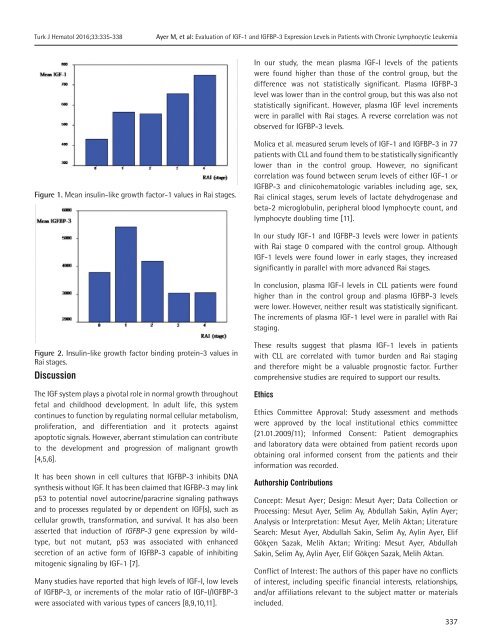Turkish Journal of Hematology Volume: 33 - Issue: 4
Create successful ePaper yourself
Turn your PDF publications into a flip-book with our unique Google optimized e-Paper software.
Turk J Hematol 2016;<strong>33</strong>:<strong>33</strong>5-<strong>33</strong>8<br />
Ayer M, et al: Evaluation <strong>of</strong> IGF-1 and IGFBP-3 Expression Levels in Patients with Chronic Lymphocytic Leukemia<br />
In our study, the mean plasma IGF-I levels <strong>of</strong> the patients<br />
were found higher than those <strong>of</strong> the control group, but the<br />
difference was not statistically significant. Plasma IGFBP-3<br />
level was lower than in the control group, but this was also not<br />
statistically significant. However, plasma IGF level increments<br />
were in parallel with Rai stages. A reverse correlation was not<br />
observed for IGFBP-3 levels.<br />
Figure 1. Mean insulin-like growth factor-1 values in Rai stages.<br />
Molica et al. measured serum levels <strong>of</strong> IGF-1 and IGFBP-3 in 77<br />
patients with CLL and found them to be statistically significantly<br />
lower than in the control group. However, no significant<br />
correlation was found between serum levels <strong>of</strong> either IGF-1 or<br />
IGFBP-3 and clinicohematologic variables including age, sex,<br />
Rai clinical stages, serum levels <strong>of</strong> lactate dehydrogenase and<br />
beta-2 microglobulin, peripheral blood lymphocyte count, and<br />
lymphocyte doubling time [11].<br />
In our study IGF-1 and IGFBP-3 levels were lower in patients<br />
with Rai stage 0 compared with the control group. Although<br />
IGF-1 levels were found lower in early stages, they increased<br />
significantly in parallel with more advanced Rai stages.<br />
In conclusion, plasma IGF-I levels in CLL patients were found<br />
higher than in the control group and plasma IGFBP-3 levels<br />
were lower. However, neither result was statistically significant.<br />
The increments <strong>of</strong> plasma IGF-1 level were in parallel with Rai<br />
staging.<br />
Figure 2. Insulin-like growth factor binding protein-3 values in<br />
Rai stages.<br />
Discussion<br />
The IGF system plays a pivotal role in normal growth throughout<br />
fetal and childhood development. In adult life, this system<br />
continues to function by regulating normal cellular metabolism,<br />
proliferation, and differentiation and it protects against<br />
apoptotic signals. However, aberrant stimulation can contribute<br />
to the development and progression <strong>of</strong> malignant growth<br />
[4,5,6].<br />
It has been shown in cell cultures that IGFBP-3 inhibits DNA<br />
synthesis without IGF. It has been claimed that IGFBP-3 may link<br />
p53 to potential novel autocrine/paracrine signaling pathways<br />
and to processes regulated by or dependent on IGF(s), such as<br />
cellular growth, transformation, and survival. It has also been<br />
asserted that induction <strong>of</strong> IGFBP-3 gene expression by wildtype,<br />
but not mutant, p53 was associated with enhanced<br />
secretion <strong>of</strong> an active form <strong>of</strong> IGFBP-3 capable <strong>of</strong> inhibiting<br />
mitogenic signaling by IGF-1 [7].<br />
Many studies have reported that high levels <strong>of</strong> IGF-I, low levels<br />
<strong>of</strong> IGFBP-3, or increments <strong>of</strong> the molar ratio <strong>of</strong> IGF-I/IGFBP-3<br />
were associated with various types <strong>of</strong> cancers [8,9,10,11].<br />
These results suggest that plasma IGF-1 levels in patients<br />
with CLL are correlated with tumor burden and Rai staging<br />
and therefore might be a valuable prognostic factor. Further<br />
comprehensive studies are required to support our results.<br />
Ethics<br />
Ethics Committee Approval: Study assessment and methods<br />
were approved by the local institutional ethics committee<br />
(21.01.2009/11); Informed Consent: Patient demographics<br />
and laboratory data were obtained from patient records upon<br />
obtaining oral informed consent from the patients and their<br />
information was recorded.<br />
Authorship Contributions<br />
Concept: Mesut Ayer; Design: Mesut Ayer; Data Collection or<br />
Processing: Mesut Ayer, Selim Ay, Abdullah Sakin, Aylin Ayer;<br />
Analysis or Interpretation: Mesut Ayer, Melih Aktan; Literature<br />
Search: Mesut Ayer, Abdullah Sakin, Selim Ay, Aylin Ayer, Elif<br />
Gökçen Sazak, Melih Aktan; Writing: Mesut Ayer, Abdullah<br />
Sakin, Selim Ay, Aylin Ayer, Elif Gökçen Sazak, Melih Aktan.<br />
Conflict <strong>of</strong> Interest: The authors <strong>of</strong> this paper have no conflicts<br />
<strong>of</strong> interest, including specific financial interests, relationships,<br />
and/or affiliations relevant to the subject matter or materials<br />
included.<br />
<strong>33</strong>7

















